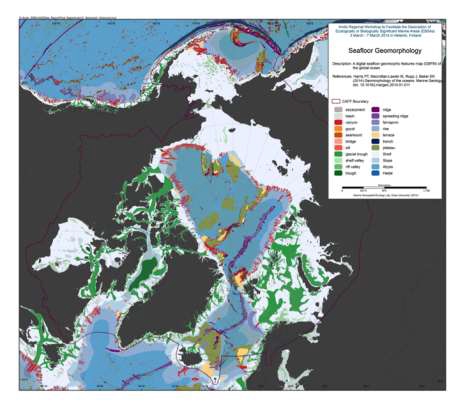Sea regions
Type of resources
Available actions
Topics
Keywords
Contact for the resource
Provided by
Years
Formats
Representation types
Update frequencies
status
Service types
Scale
-

We present the first digital seafloor geomorphic features map (GSFM) of the global ocean. The GSFM includes 131,192 separate polygons in 29 geomorphic feature categories, used here to assess differences between passive and active continental margins as well as between 8 major ocean regions (the Arctic, Indian, North Atlantic, North Pacific, South Atlantic, South Pacific and the Southern Oceans and the Mediterranean and Black Seas). The GSFM provides quantitative assessments of differences between passive and active margins: continental shelf width of passive margins (88 km) is nearly three times that of active margins (31 km); the average width of active slopes (36 km) is less than the average width of passive margin slopes (46 km); active margin slopes contain an area of 3.4 million km2 where the gradient exceeds 5°, compared with 1.3 million km2 on passive margin slopes; the continental rise covers 27 million km2 adjacent to passive margins and less than 2.3 million km2 adjacent to active margins. Examples of specific applications of the GSFM are presented to show that: 1) larger rift valley segments are generally associated with slow-spreading rates and smaller rift valley segments are associated with fast spreading; 2) polar submarine canyons are twice the average size of non-polar canyons and abyssal polar regions exhibit lower seafloor roughness than non-polar regions, expressed as spatially extensive fan, rise and abyssal plain sediment deposits – all of which are attributed here to the effects of continental glaciations; and 3) recognition of seamounts as a separate category of feature from ridges results in a lower estimate of seamount number compared with estimates of previous workers. Reference: Harris PT, Macmillan-Lawler M, Rupp J, Baker EK Geomorphology of the oceans. Marine Geology.
-
Norwegian Download service for INSPIRE Sea Regions.
-
<p>Happywhale.com is a resource to help you know whales as individuals, and to benefit conservation science with rich data about individual whales.-nbsp;</p>
-
<p>Happywhale.com is a resource to help you know whales as individuals, and to benefit conservation science with rich data about individual whales.-nbsp;</p>
-
<p>Abstract: Happywhale.com is a resource to help you know whales as individuals, and to benefit conservation science with rich data about individual whales.-nbsp;</p>
-
This dataset was compiled to describe the intertidal meiobenthic community of Kongsfjorden and to better understand the relationship between the horizontal and vertical distribution of meiofauna with a special focus on nematodes and environmental features
-
<p>Happywhale.com is a resource to help you know whales as individuals, and to benefit conservation science with rich data about individual whales.-nbsp;</p>
-
<p>Happywhale.com is a resource to help you know whales as individuals, and to benefit conservation science with rich data about individual whales.-nbsp;</p>
-
<p>Happywhale.com is a resource to help you know whales as individuals, and to benefit conservation science with rich data about individual whales.-nbsp;</p>
-
<p>The study of long-distance migration provides insights into the habits and performance of organisms at the limit of their physical abilities. The Arctic tern Sterna paradisaea is the epitome of such behavior; despite its small size (-lt;125 g), banding recoveries and at-sea surveys suggest that its annual migration from boreal and high Arctic breeding grounds to the Southern Ocean may be the longest seasonal movement of any animal. Our tracking of 11 Arctic terns fitted with miniature (1.4 g) geolocators revealed that these birds do indeed travel huge distances (more than 80,000 km annually for some individuals). As well as confirming the location of the main wintering region, we also identified a previously unknown oceanic stopover area in the North Atlantic used by birds from at least two breeding populations (from Greenland and Iceland). Although birds from the same colony took one of two alternative southbound migration routes following the African or South American coast, all returned on a broadly similar, sigmoidal trajectory, crossing from east to west in the Atlantic in the region of the equatorial Intertropical Convergence Zone. Arctic terns clearly target regions of high marine productivity both as stopover and wintering areas, and exploit prevailing global wind systems to reduce flight costs on long-distance commutes.-nbsp;</p>
 Arctic SDI catalogue
Arctic SDI catalogue